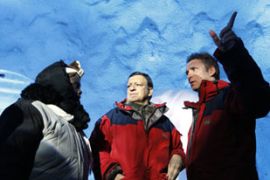Norway opens ‘Doomsday’ seed vault
Prime minister inaugurates protected frozen cavern, seen as ‘Noah’s Ark’ for plants.

Published On 26 Feb 2008
Backup plan
The cavern will act as a backup storage for seeds from gene banks around the world.
Initially, 100 million seeds from more than 100 countries have been sent for safekeeping at the $10m facility which holds 268,000 distinct seed samples, each from a different farm or field.
Stoltenberg said the vault, would guard “the fundamental building blocks of human civilisation” from forces, including climate change, threatening the “diversity of life that sustain our planet”.
The Norwegian prime minister and Wangari Maathai, a Kenyan environmentalist and 2004 Nobel peace prize winner, put the first box of seeds in the vault at the inauguration ceremony.
The ‘Doomsday’ vault’s seed deposits range from major African and Asian staples such as rice, maize, wheat, cowpea and sorghum to European and South American varieties of eggplant, lettuce, barley and potato.
‘Frozen Garden of Eden’
“We will have a major [seed] collection here, one of the biggest in the world, from the opening day,” Cary Fowler, head of the Global Crop Diversity Trust, which is funding the operations of the vault, said.
“We are going to put an end to extinction with this vault because we are going to have a safety backup, a Plan B.”
Jose Manuel Barroso, the European commission president, was also at the ceremony.
He called the project “a frozen Garden of Eden”.
Roger Smith, the founder of the Millennium Seed Bank in the UK’s Kew Gardens, told Al Jazeera there needed to be greater understanding of just how endangered some plant life is.
“We’re talking about a something like a rate of extinction 70 times greater for plants than is in the geographical record – we’re talking about thousands of species being lost,” he said.
Smith called the Svalbard vault a “double indemnity”, saying “it is the safe deposit box where seed banks can put some of their contents for security”.
The seeds will be kept at a storage temperature of minus 18-20 degrees Celsius.
Barley can survive 2,000 years, wheat 1,700 and sorghum almost 20,000 years under such conditions, according to the Global Crop Diversity Trust.
If the freezers failed, the permafrost would keep the cavern at around minus 4 Celsius, allowing time for repairs.
“I like having a Plan B to our Plan B,” Fowler said.
Source: Al Jazeera, News Agencies